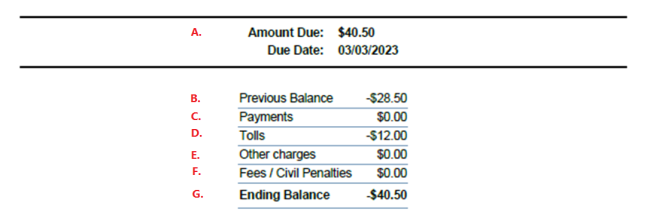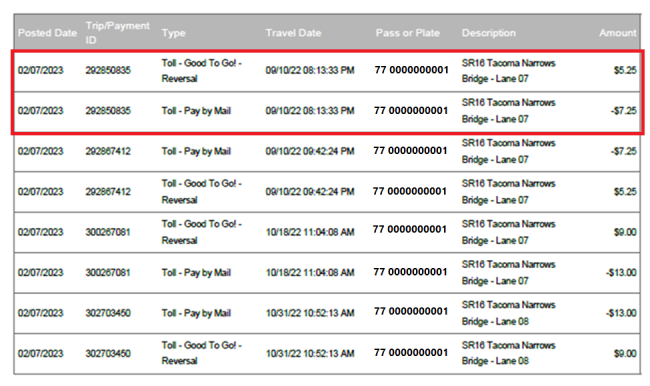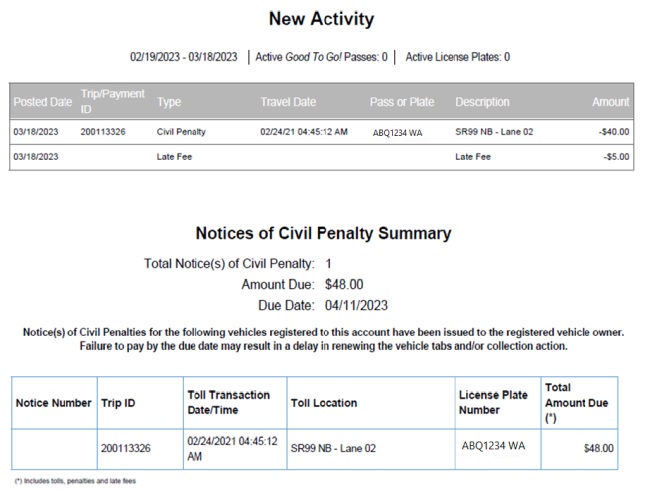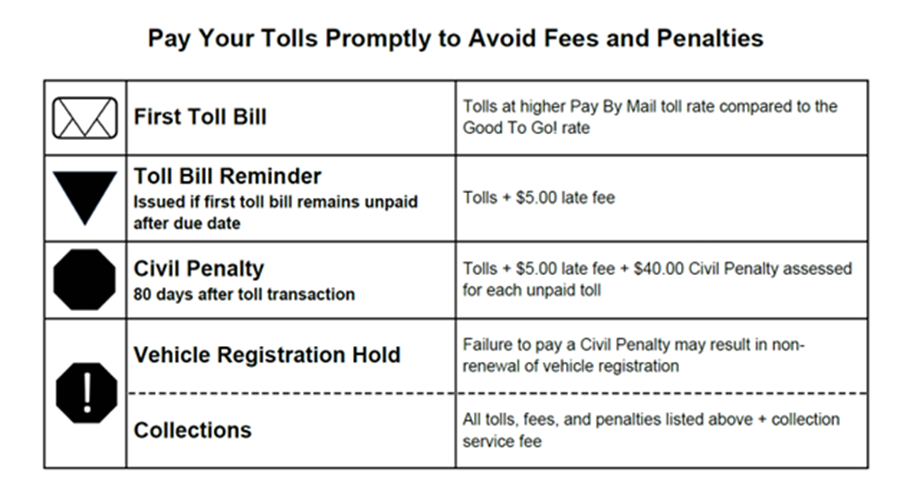Understanding your toll bill or civil penalty
Learn how to understand your toll bill and civil penalty and how to find important information.
Toll bills and statements look at little different in the new Good To Go! system, but this guide will explain how to read and understand all the new aspects including the alerts, balance breakdown, new activity, reversals and Notices of Civil Penalty.
Following the launch of the new Good To Go! system in July 2021, WSDOT paused charging late fees and civil penalties, and requesting registration holds. WSDOT’s vendor needed sufficient time to implement the necessary changes to the system to resume charging late fees and penalties, which provided a grace period for customers to adjust to the new toll billing system. That grace period ended March 1 and customers will now see unpaid tolls incurring late fees and civil penalties that could date back to June 2021.
Alerts
On the front page of your bill, the first things you’ll most likely notice are the alert boxes.
Account Alerts – Good To Go! customers only
If you’re signed up for Good To Go! and there’s an issue with your account, you’ll see a gray box labeled “Account Alerts.” This box will feature important account alerts such as an expired credit card or failed payment. If there’s nothing wrong with your account, you won’t see this box.
Important Alerts – Good To Go! and Pay By Mail customers
Every bill has a green alert box notifying you to the status of your bill.
It’s important to pay attention to these alerts, as ignoring them could lead to billing issues, extra fees, penalties, or a hold with the Department of Licensing preventing renewal of your vehicle’s tabs.

Amount due – breakdown of balance
The balance breakdown shows what may be reflected in your amount due. This includes:
A. Amount due – This is the amount that you owe today.
B. Previous balance – This will be the previous balance on your last bill. If the number is negative, it reflects any tolls that remain unpaid from your last bill. If the number is positive, you likely have money on a Good To Go! account – and there is no amount due.
C. Payments – Includes any payments, refunds, reversals or credits since your last statement.
D. Tolls – Total of any new tolls from trips taken since your last statement.
E. Other charges – Miscellaneous charges, such as pass purchases, will be shown here.
F. Fees/Civil penalties – Any $5 late fees or $40 civil penalties charged since your last statement.
G. Ending balance – Ending balance should typically be the same number as the amount due. Since it’s characterized as a balance however, it will be listed as a negative number if you owe anything, similar to a bank account.

In the example above, you can see that the balance due is $40.50 and payment is due on March 3, 2023. Reading the balance breakdown shows that the customer previously owed $28.50 from their last statement and incurred $12 in new toll charges.
New activity
On the second page of your bill, you’ll find the “New Activity” section, which lists everything that has happened to your account since your previous statement. This activity can include new toll charges, pass purchases, fees and penalties, payments, and reversals.
Activity is sorted by “Posted Date” which represents when the transaction posted to your account (as opposed to “Travel Date” which shows the date and time of the toll trip).
Charges to your account are negative numbers displayed in the amount column, while credits to your account are positive numbers.
Reversals
There are two types of reversals:
- Good To Go! account reversals – If a toll remains unpaid for at least a month, the initial toll will be credited back to the account and reapplied at the higher Pay By Mail rate.
- Other reversals – Tolls that are dismissed may also be labeled as reversals. Tolls may be dismissed for a variety of reasons.
How to understand Good To Go! account reversals
For a Good To Go! pass reversal:
If a trip with a Good To Go! pass remains unpaid, there will be two posts when the trip is reversed:
- Initial posting of trip will be shown as: Toll – Good To Go! Reversal
- New posting of trip will be shown as: Toll – Pay by Mail
The initial toll will be credited back to your account, and then the toll will be re-posted at a higher rate and shown on the bill. A customer can determine which two postings are tied together by looking at the Trip ID or the trip date/time, which will be the same for both transactions.

For a Good To Go! Pay By Plate reversal:
If a Good To Go! Pay By Plate trip remains unpaid, there will be three posts when that trip is reversed:
- Initial posting of trip will be shown as: Toll – Good To Go! Reversal
- Initial posting of 25-cent fee will be shown as: Fee – Pay By Plate – Reversal
- New posting of trip will be shown as: Toll – Pay by Mail
A customer can determine which postings are tied together by looking at the Trip ID or the trip date/time, which will be the same for both transactions.

Notices of Civil Penalty
A customer with civil penalty will receive two separate envelopes with different documents in the mail.
- Toll Bill – A regular monthly toll bill which includes all new activity and total amount due.
- Civil penalty – Which only includes details for trips that received a civil penalty. This also includes images of the vehicle’s license plate.
Where will the two envelopes, one with the toll bill and the other with the NOCP, be mailed?
- Toll Bill– For Pay By Mail customers, the toll bill will be mailed to the vehicle's registered owner as listed with the Department of Licensing. For Good To Go! customers, the toll bill will be mailed to the name/address on the Good To Go! account.
- Civil penalty – The civil penalty is mailed to the vehicle's registered owner as listed with the Department of Licensing, as required by state law.
How to understand a Toll Bill with a toll that has received a civil penalty
If the vehicle’s registered owner has been issued a civil penalty, you’ll see it the “Notices of Civil Penalty” summary located beneath the “New Activity” section.

The Notices of Civil Penalty Summary above includes:
- The $48 includes the toll trip ($3) that was escalated to civil penalty, the $5 fee and the $40 civil penalty. (Note: the $3 toll would’ve been billed on a previous statement, which is why you don’t see it listed the New Activity table above).
- The Trip ID 200113326 is the same as shown the New Activity table and in the separate civil penalty.
- This amount due at the top of the Notice of Civil Penalty Summary should be the same as the separate civil penalty that was mailed.
Notice of Civil Penalty – This is mailed separately from the Toll Bill

Fees and penalties for unpaid bills
For more information about fees and civil penalties please visit the Good To Go! Accounts & passes page.
If there is something on your bill you would like to dispute, please visit our dispute page to find out how to dispute a charge, what documentation you need, and valid reasons for disputing a charge or bill.

Pay your bill online at MyGoodToGo.com.
Please take a moment to participate in this short survey to share feedback on if this page helped you understand your bill, answered your questions, and to share your thoughts on how we can make these bills easier to understand. The survey will take less than three minutes to complete.
Slow down – lives are on the line.
Excessive speed was a top cause of work zone collisions in 2024.
Phone down, eyes up.
Work zones need our undivided attention.
It's in EVERYONE’S best interest.
96% of people hurt in work zones are drivers, their passengers or passing pedestrians, not just our road crews.
